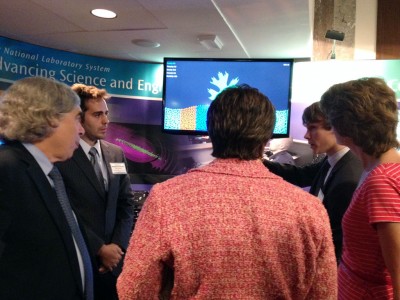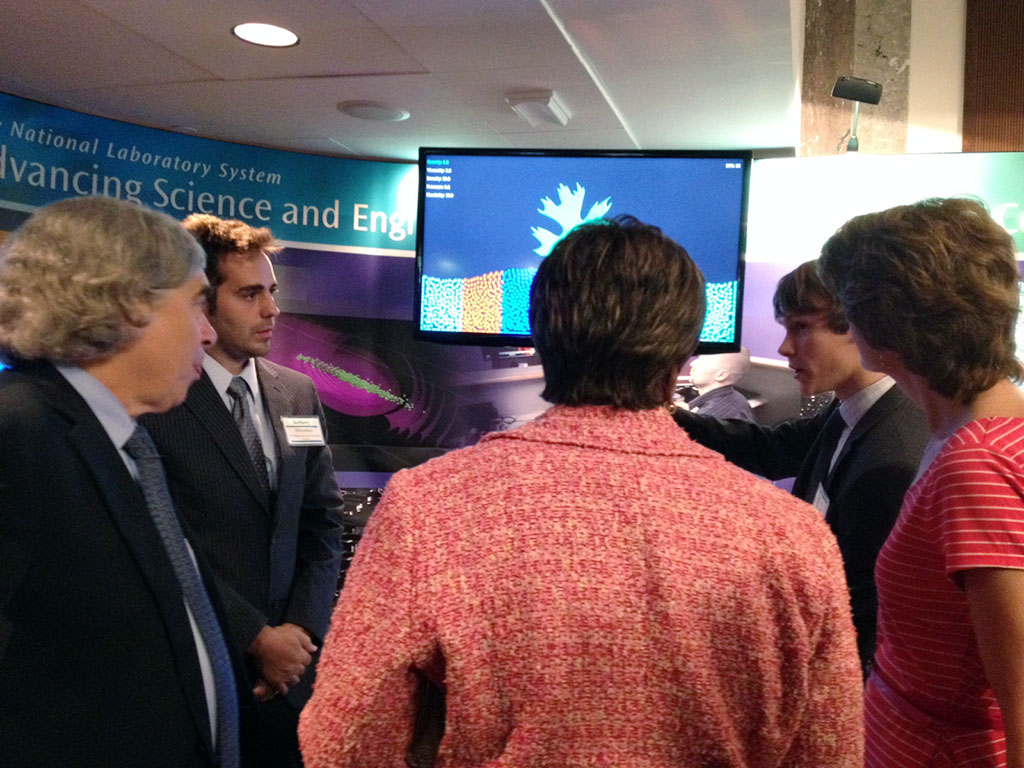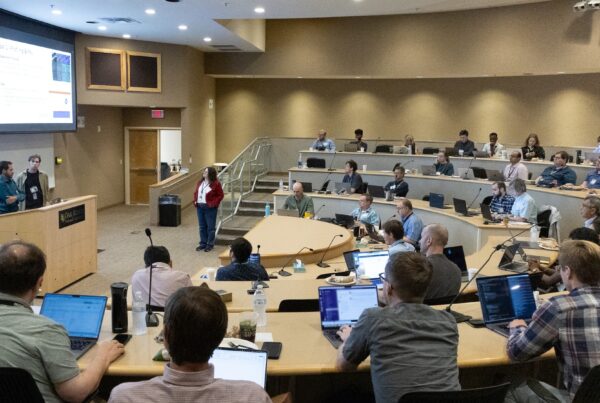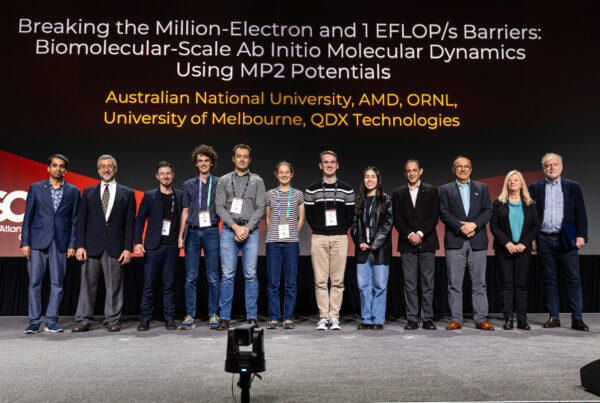
OLCF staff members Anthony DiGarolamo and Adam Simpson (back, left and right) explain parallel computing in a nutshell to Secretary of Energy Ernest Moniz, U.S. Representative Eddie Bernice Johnson, and Senator Lisa Murkowski (front, left to right).
OLCF staffers, partner lab representatives communicate HPC in the capital
For being so small, Tiny Titan has been making a big splash. In the last few months, the semi-supercomputer has made quite an impression on students, teachers, and the public. Most recently it impressed politicians.
On September 16, Secretary of Energy Ernest Moniz, along with Senators Dick Durbin and Jim Risch, welcomed lab directors and representatives from each of the nation’s 17 national laboratories—including the Tiny Titan team from the Oak Ridge Leadership Computing Facility (OLCF) at Oak Ridge National Laboratory (ORNL)—to Washington, D.C., for the inaugural National Lab Day on the Hill.
The new initiative was aimed at highlighting science achievements to lawmakers and stressing why the continued support of the national laboratories is critical to the nation’s future. The event’s five major themes were energy innovation and environmental sustainability, manufacturing innovations, discovery science, national security, and high-performance computing (HPC).
Tremendous, though tiny
OLCF staff members Adam Simpson, Anthony DiGirolamo, and Suzanne Parete-Koon helped staff the booth and showed off the capabilities of Tiny Titan. A portable nine-core parallel computer based on an inexpensive Raspberry Pi cluster, Tiny Titan was built by the trio and their colleague Robert French to bolster the younger generation’s interest in supercomputing.
“In the past there hasn’t been a good way to explain to people, in a few minutes, how a supercomputer works,” Simpson said. “Tiny Titan allows us to do that.”
Its popularity is due in part to its aesthetic appeal, DiGirolamo said. Using one of the two connected Xbox controllers, users can manipulate a basic fluid dynamics code displayed on the monitor. Each core, when activated, is displayed onscreen as a different color to show the user the difference in rendering speeds when only one core is operational as opposed to multiple cores working together.
On a grander scale, Simpson and DiGirolamo said, the idea that computational sciences can be presented in a fun, visual way makes it appealing to children and teens. Furthermore, the fact that this incredible tool can be built for less than $1,000 by students using the OLCF plans should make it appealing to educators.
According to the Tiny Titan team, Secretary Moniz was inclined to agree. During a VIP tour of the event’s exhibits, Secretary Moniz, Senator Lisa Murkowski (R-Alaska), and Congresswoman Eddie Bernice Johnson (D-Texas) showed a genuine interest in Tiny Titan and encouraged the team to make the technology available to schools as soon as possible.
That effort is underway, as the team currently is working to publish Tiny Titan’s specs on an open-source platform.
“It was nice to see all the labs together in one location to share their innovations,” DiGirolamo said. “And, it’s not every day that the Secretary of Energy tells you in person that the work you’re doing is important. That was pretty nice, too.”
After guests learned how supercomputers work, they could take a few steps over to the
HPC Petting Zoo—set up by Cray and IBM—to get hands-on with actual components from past and present supercomputers. There, Parete-Koon and Lawrence Livermore National Laboratory’s Kim Cupps fielded questions from the public and members of Congress, and provided science examples explaining why supercomputers and national labs matter and how they affect Americans.
“In our booth, you could look at the science pictures and stories we brought and our interactive display of science gained from the different labs’ production computational resources and see how the HPC concepts illustrated with Tiny Titan and the hardware in the HPC petting zoo could scale up to produce powerful tools for scientific inquiry.” said Parete-Koon
Support for HPC
In his opening remarks to the roughly 1,500 attendees at Lab Day, Moniz emphasized the importance of HPC in the national lab system and how it has proven to be an invaluable resource to scientists and the world. Research conducted on supercomputers has shown its impact not only on industry and the economy but also in medicine and the propensity to improve lives.
He reminisced about the successful push in the 1990s for 100 teraflop systems. The next big push, he said, will be ensuring the groundwork going to exascale, and how HPC and the national lab system will be vital to that initiative.
Durbin and Risch followed Moniz with similar statements of their own, formally announcing the bipartisan launch of the Senate National Laboratory Caucus, which will focus on strengthening the labs’ achievements in innovation and their contribution to the growth of the economy, as well as address funding and policy challenges.
“The laboratories are a place where we can provide enabling tools for research that are important for our mission,” Moniz said in his Lab Day address. “I think today’s event, and the exhibits you will see, hopefully will carry the message that we view this as a system with tremendous capacity.”
—Jeremy Rumsey






